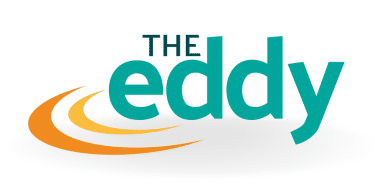
Are you interested in securing buy-in from your employees, increasing the overall stoke factor for your business, and adding more money to your bottom line? Consider building a reward program.
At Zebulon, we methodically engineer reward programs around an outfit’s specific needs. We also carefully factor in the included employees’ goals and aspirations. This ensures that everyone involved feels like they get a fair piece of the pie.
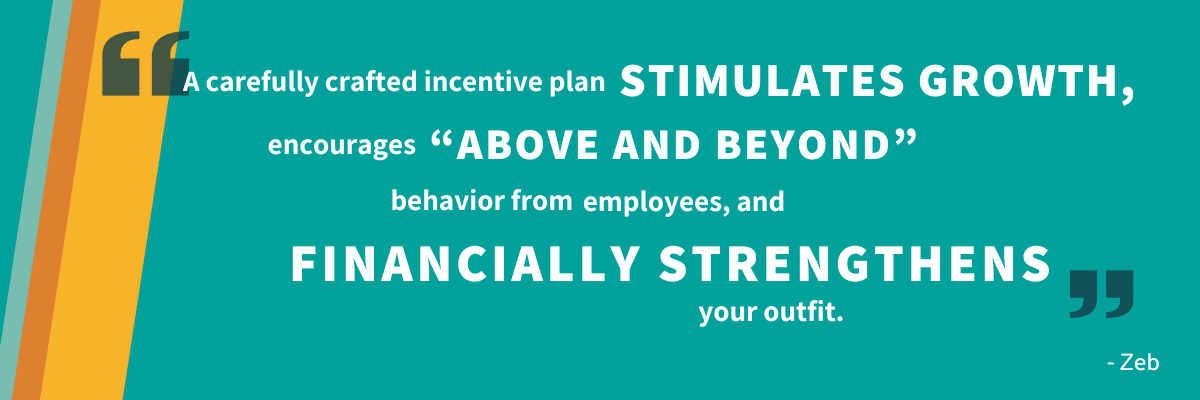
Plan Prerequisites
Reward programs are so much more than tossing around a simple end-of-season bonus. A carefully crafted reward program stimulates growth, encourages “above and beyond” behavior from employees, and financially strengthens your outfit.
When implementing reward programs, you’ll want to keep certain key considerations at hand. Coincidentally, we dedicated an entire month of The Eddy, our leadership peer group, to each of the following reward program “prerequisites”:
Previous Season Recap
At the close of each season, you should look critically at your outfit’s numbers for that year. Previous Season Recaps are data-driven opportunities to determine what went well and what needs to be improved. In terms of building reward programs, conducting a Previous Season Recap proves useful for pinpointing initiatives you want to encourage your team to improve upon from last season, or highlight bright spots where you want to keep momentum flowing.
Employee Grading
After you’ve shut operations down for the season and completed your Previous Season Recap, we recommend taking a hard look at your employee roster and confidentially grading your staff in various categories. Doing so, you’ll quickly identify your top 10-20% employees in terms of performance, attitude, and more. (Not to mention bring to light your worst-performing 10-20%.)
Once you’ve graded your employees, numerous things will become crystal clear. Namely, you’ll know who you’d like to invite back year over year. You’ll know exactly which diamond-in-the-rough employees should be on the fast track to becoming supervisors and leaders. And, you’ll determine who would be great candidates for a personalized reward program.
Multi-Vision
This is a Zebulon-original exercise for owners and leaders to define personal and professional goals. The Multi-Vision provides a framework for timelines (are these 1-year, 3-year, or 5+-year goals?) as well as guidance for calculating the finances required to reach those goals.
As owners and leaders, defining your short-term and long-term goals will clarify what types of reward program you should implement. Also, understanding what makes your top employees tick, and discovering their personal and professional goals, will help you structure your reward programs for success.
We know first-hand that employees feel extra invested in reward programs when bonuses align with their own personal goals. The employees’ original ideas turn into a proverbial carrot attached to pre-set outcomes. For example, one GM we work with dreamed of taking a bucket-list 3-week long rafting trip in the Grand Canyon to the tune of about $7,000. Well, guess how much that summer’s reward program promised if all goals were met?
Supervisor Roles
As you introduce supervisor roles into your outfit’s depth chart, it can be tricky to obtain buy-in from inexperienced workers. After all, employees just trade their time for a paycheck, right? Wrong.
Appropriately designed reward programs can be the perfect sweetener for new workers stepping into supervisory roles. These programs are also a concrete way to demonstrate the perks of building a long-term working relationship with your outfit.
Responsibility Charting
Clarifying tasks and responsibilities via Responsibility Charting not only makes for a more efficient outfit, it helps pinpoint those initiatives around which reward program would have the most impact.
First, if you’ve cleared numerous tasks off your own responsibility chart, you may have shed enough responsibilities to create an entirely new position. In this instance, a front-end reward may help attract the ideal (and appropriately qualified) candidate for the new role. We’ll talk more about “front-end” plans in a minute.
Second, if you follow our suggested flowchart and use our triage questions to determine everyone’s optimal task lists (all while eliminating unnecessary or outdated tasks), your outfit’s most crucial tasks – and those with outsize impacts – will come to light. If your supervisors go above and beyond by stepping up to assume some of these crucial new tasks, reward programs can increase buy-in and up their chances of successfully completing them.
Note: You shouldn’t get in the habit of building rewards around your employees’ regular, run-of-the-mill responsibilities. Use Responsibility Charting to identify the tasks and responsibilities that will have the biggest impact if your team excels at them.
Fitting Reward Programs Into Your Outfit’s Strategic Timeline
Now’s the perfect time to introduce our Time Cone, which is a strategic way of looking at your outfit’s longevity. Essentially, the farther into the future you look, the less hard data you deal with.
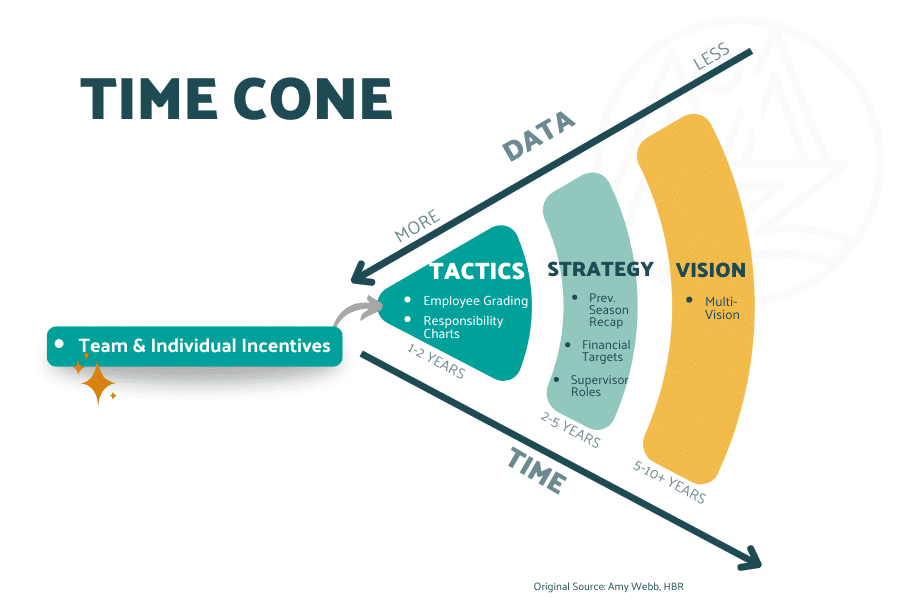
When you picture your business 5-10 years from now, you’re creating a long-term vision for your outfit. This includes conceptualizing how much you want to grow, the type of people you want helping run the place, and even your eventual exit plan.
Looking ahead 2-5 years in the future, you’re building a strategy powered with more data-driven decisions. This is where the previous season recap fits in, as well as financial targets to afford your vision. This is also home to the nurture process of building supervisor roles in your outfit (which is a multi-year process, by the way).
As you get closer to the tip of the Time Cone, you’re honing in on the immediate future. This involves plans for just 1-2 years from now, and sometimes even “this year” items. Decisions made in the tip of the Time Cone have an immediate impact on your outfit. As such, this is where Employee Grading, Responsibility Charting, and today’s topic of Reward Programs come into play.
The tip of the time cone is where tactical exercises lay. The best rewards are built to stimulate outcomes in a single season, and they tend to generate immediate positive reverberations throughout your outfit.
Front End vs. Back End
Reward programs can take multiple forms. You could build a reward on the front end of your employee process (i.e. in the hiring phase). Or, you could build one on the back end (i.e. once employees are already hired, onboarded, and hopefully developing a long-term working relationship with your outfit).
For example, a front-end reward would be used to attract top talent. These often include retirement, health, and other traditional benefits. You’re effectively incentivizing recruits to work with you instead of another employer.
Another front-end example encourages employees to level-up their talents for a one-time payout or a step up in pay. In the industry-specific case of outfitting, this includes things like a small raise for specific up-to-date certifications (WFR, CPR, etc.).
On the back end, reward programs are excellent tools for motivating employees and encouraging specific outcomes (such as five-star reviews online). Programs can be geared toward individual workers, such as offering gift cards to whichever employee sells the most retail in a week, which builds a competitive atmosphere. They can also be geared toward entire groups of employees, such as contributing money to an end-of-season bonus pool each time the reservation team secures a certain amount of upsells, which builds camaraderie and a team atmosphere.
On the back end, it’s key that you understand who your reward program will be geared toward, and what makes them tick. If the target employee group is motivated individually, build a plan that creates a competitive atmosphere. If they’ve got great chemistry as a cohort, build a plan that creates a friendly, team atmosphere.
Funds For Employees Analysis
When building a reward program, you don’t want to promise extra money all willy-nilly. Before you go further, you need to know exactly how much money is available for employee rewards.
The technique for uncovering this amount is what we call the “Funds For Employees Analysis.” The FFE Analysis is a simple equation: First, take your expected season revenue and subtract your target net profits for the year. (Note: it’s super crucial to protect those profits – not to line your own pockets, but to build up your company’s financial health.)
Next, subtract all non-employee expenses (which includes overhead, insurance, promo, etc.). The amount you’re left with is the total pool of funds available for employees. From here, subtract all employee wages and any necessary employee insurance payments, training costs, meals, existing benefits, and all other money already paid to employees. The amount you’re left with is an honest, healthy estimate of the funds you can build into your reward program.
This is a great time to consider different scenarios and calculate the impact a 10% drop or increase in customer volume will have on your FFE amount. Build your reward program accordingly.
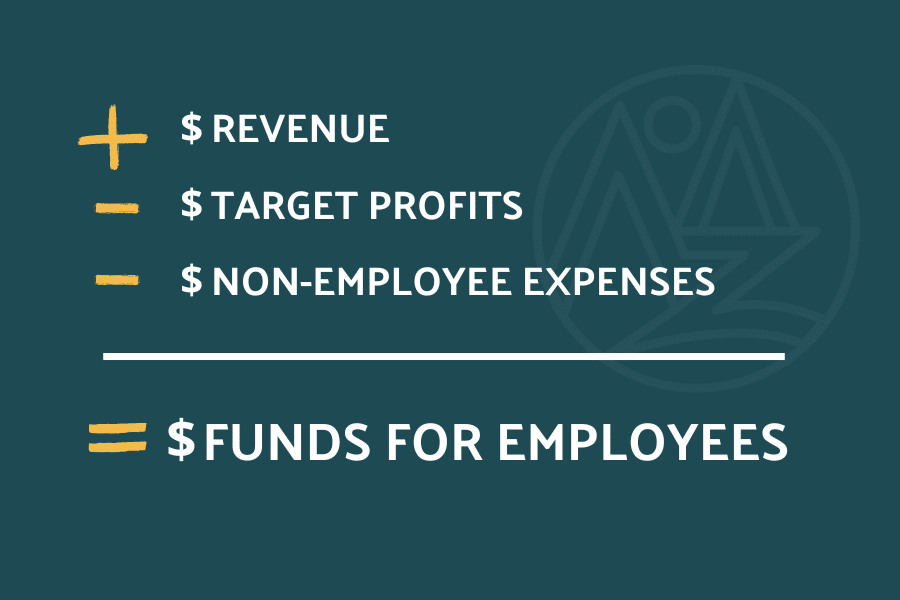
Building Reward Programs
So, you’ve completed the reward program prerequisites. You’ve shifted focus to the tip of your outfit’s Time Cone, and you’re ready to do a FFE analysis so you know exactly how much money is at-hand. Now what?
It’s time to build your own reward program. Here is our tried-and-true, 6-step process to build a custom plan:
Step 1: What is the desired outcome?
Look back at everything we considered earlier in this article. What initiatives will have the biggest, most positive impact on your organization? Will you focus on building your outfit’s hierarchy and create high-performing supervisors with a sense of ownership? Should you drive revenue by improving customer perception and increasing the number of reviews? Do you need to cut back on expenses, or establish a system to minimize the number of paddles lost downriver?
Step 2: How much money is available?
Carefully run your Funds For Employee Analysis to arrive at a concrete number to bake into your reward program. Remember: set aside your outfit’s target profits before all else.
Step 3: Who will you reward?
Determine if your reward program will revolve around 1-2 key players in your leadership team, or around an entire sub-group of employees. Depending on the employees involved, you’ll want to be intentional around creating either an individual-first, competitive atmosphere, or a group-first atmosphere of camaraderie. You should also get employee buy-in by leaning into the individual’s or the group’s goals.
Step 4: Which metrics do you need to hit?
Don’t leave room for confusion. Be clear about exactly which outcomes and supporting numbers your team needs to hit. We highly recommend the “SMART” framework here: targets should be Specific, Measurable, Attainable, Realistic, and Timely.
Step 5: How often will you monitor metrics?
As the saying goes, nothing gets done if it doesn’t get measured. You’ll want to run the numbers and announce progress frequently enough to keep things buzzing. The exact methods of notifying about progress and sharing metrics will depend on your particular reward specifics. For example, you may want to initiate bi-weekly team meetings among your retail crew to share progress. Or, you may already have frequent stand-ups around the equipment barn that are perfect for providing updates on the number of paddles lost – or recovered – that week.
Step 6: When will you make disbursements?
Will your rewards be paid on the front-end (like a sign-on bonus), or on the back-end (when goals are hit)? Will you make multiple payments over the course of the goal period, or wait until the end of the season to do one big one?
Payments can be especially tricky. On the one hand, you want to keep buzz flowing and continue to encourage employees with immediate gratification. On the other hand, you don’t want to deplete funds too soon. Instead, you should prioritize being in a good annualized cash position before making disbursements.
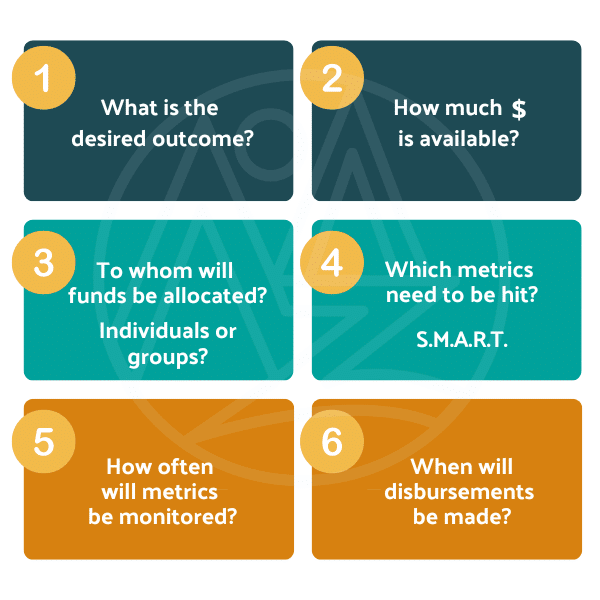
Other Considerations When Building Reward Programs
Don’t get lazy by using the same incentives year over year. This bad habit sets employee expectations that they’ll be rewarded for the same outcomes – meaning it becomes their expectation, not yours.
As we all know, business is fluid and things change over time. This is especially true in outfitting when things change at the drop of a hat. So, keep reward programs fresh and exciting, and build new ones around specific goals each season. This keeps employees on their toes, curious about each year’s plans, and hungry to hit new benchmarks. Factor in details pertaining to the specific leaders or people you want to help grow. Both your employee roster and the economy change often, so your reward programs should too.
Lastly, don’t forget to reinforce to your employees that these are “above and beyond” bonuses, which are generously provided by owners and managers to reward next-level behavior. While the objective is to incentivize good behavior, you also want to be clear that if metrics aren’t hit, or if attitudes are in the gutter, the rewards won’t be paid.
Don’t Just Take Our Word For It …
This article covers one of the core topics discussed in our Eddy group, a non-competitive meeting space for growth-focused outfit owners and leaders. We spent multiple meetings discussing strategies for reward programs, and we shared detailed specifics and how-to’s of some of the Eddy members’ own initiatives.
If you own or lead an innovative and knowledge-hungry outfit, and would like to join our timely and relevant leadership group by getting on retainer with us, reach out to us below.



